
The flood prayer (German : Sindflutgebet [1] [2] ) is a prayer written by Martin Luther in 1523 and attached to the baptismal liturgy.

The flood prayer (German : Sindflutgebet [1] [2] ) is a prayer written by Martin Luther in 1523 and attached to the baptismal liturgy.

In 1523, Luther translated the Roman baptismal rite from Latin to German and in so doing he extensively revised it. Most of the revisions involved omitting material, but he also added the flood prayer to the service. [3] This was included in his "Baptismal Booklet" (German: Taufbüchlein). [4]
While the prayer was traditionally regarded as Luther's own composition, "recent scholarship has asserted that it was more than likely a prayer translated and edited from a blessing of baptismal water in a yet-to-be identified medieval ritual at his disposal." [2] Isidore of Seville and Rupert of Deutz have both been suggested as possible sources. [5]
The flood prayer was adopted by the Continental Reformed churches. [6] It was included in a modified form in the Book of Common Prayer of the Church of England in 1549 and continues to be used there under the "Public Baptism of Infants". [7] [8]
The text of the prayer as it found in the Lutheran Church – Missouri Synod's Lutheran Service Book goes as follows: [3]
Almighty and eternal God, according to Your strict judgment You condemned the unbelieving world through the flood, yet according to Your great mercy You preserved believing Noah and his family, eight souls in all. You drowned hard-hearted Pharaoh and all his host in the Red Sea, yet led Your people Israel through the water on dry ground, prefiguring this washing of Your Holy Baptism. Through the Baptism in the Jordan of Your beloved Son, our Lord Jesus Christ, You sanctified and instituted all waters to be a blessed flood, and a lavish washing away of sin. We pray that You would behold (name) according to Your boundless mercy and bless him with true faith by the Holy Spirit that through this saving flood all sin in him which has been inherited from Adam and which he himself has committed since would be drowned and die. Grant that he be kept safe and secure in the holy ark of the Christian Church, being separated from the multitude of unbelievers and serving Your name at all times with a fervent spirit and a joyful hope, so that, with all believers in Your promise, he would be declared worthy of eternal life, through Jesus Christ, our Lord.
The Book of Common Prayer version removed the reference to Pharaoh but still kept the Red Sea and Noah's Ark: [8]
Almighty and everlasting God, who of thy great mercy didst save Noah and his family in the ark from perishing by water; and also didst safely lead the children of Israel thy people through the Red Sea, figuring thereby thy holy Baptism; and by the Baptism of thy well-beloved Son Jesus Christ, in the river Jordan, didst sanctify Water to the mystical washing away of sin: We beseech thee, for thine infinite mercies, that thou wilt mercifully look upon this Child; wash him and sanctify him with the Holy Ghost; that he, being delivered from thy wrath, may be received into the ark of Christ's Church; and being stedfast in faith, joyful through hope, and rooted in charity, may so pass the waves of this troublesome world, that finally he may come to the land of everlasting life, there to reign with thee world without end, through Jesus Christ our Lord.
The Canadian Reformed Churches base only the first paragraph of their "Prayer Before Baptism" on the flood prayer": [9]
Almighty, eternal God, in your righteous judgment you punished the unbelieving and unrepentant world with the flood, but in your great mercy saved and protected the believer Noah and his family. You drowned the obstinate Pharaoh and all his host in the Red Sea, but led your people Israel through the midst of the sea on dry ground—by which baptism was signified.
The prayer draws on 1 Peter 3:20-21: "...when God's patience waited in the days of Noah, while the ark was being prepared, in which a few, that is, eight persons, were brought safely through water. Baptism, which corresponds to this, now saves you..." (ESV). It also alludes to 1 Corinthians 10:2, which says that "our fathers... were baptized into Moses in the cloud and in the sea". The idea is that both the Red Sea and the water of Noah's Flood served a dual purpose of punishing the ungodly and saving the godly. Baptism is viewed therefore as a means of separating a person from the world. Zachary Purvis notes that anamnesis, "the remembrance of God’s mighty deeds in history," is employed to great effect. [5]
The baptism then moves forward to the Baptism of Jesus; Mark Tranvik notes that "the prayer funnels this story of Jesus and John the baptizer from fifteen hundred years ago directly into the life of the one being baptized. He or she now stands through baptism as the recipient of the same saving flood." [1]
Hughes Oliphant Old has noted that "Viewed in terms of biblical imagery, liturgical history, and pastoral sensitivity, Luther's prayer is a masterpiece." [6]
The Apostles' Creed, sometimes titled the Apostolic Creed or the Symbol of the Apostles, is a Christian creed or "symbol of faith".
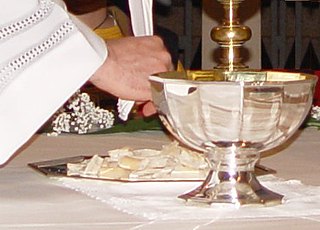
Agnus Dei is the Latin name under which the "Lamb of God" is honoured within Christian liturgies descending from the historic Latin liturgical tradition, including those of Roman Catholicism, Lutheranism and Anglicanism. It is the name given to a specific prayer that occurs in these liturgies, and is the name given to the music pieces that accompany the text of this prayer.
An Act of Contrition is a Christian prayer genre that expresses sorrow for sins. It may be used in a liturgical service or be used privately, especially in connection with an examination of conscience. Special formulae for acts of contrition are in use in the Anglican, Catholic, Lutheran, Methodist and Reformed Churches.

The epiclesis refers to the invocation of one or several gods. In ancient Greek religion, the epiclesis was the epithet used as the surname given to a deity in religious contexts. The term was borrowed into the Christian tradition, where it designates the part of the Anaphora by which the priest invokes the Holy Spirit upon the Eucharistic bread and wine in some Christian churches. In most Eastern Christian traditions, the Epiclesis comes after the Anamnesis ; in the Western Rite it usually precedes. In the historic practice of the Western Christian Churches, the consecration is effected at the Words of Institution though during the rise of the Liturgical Movement, many denominations introduced an explicit epiclesis in their liturgies.
Sanctification literally means "to set apart for special use or purpose", that is, to make holy or sacred. Therefore, sanctification refers to the state or process of being set apart, i.e. "made holy", as a vessel, full of the Holy Spirit of God. The concept of sanctification is widespread among religions, including Judaism and especially Christianity. The term can be used to refer to objects which are set apart for special purposes, but the most common use within Christian theology is in reference to the change brought about by God in a believer, begun at the point of salvation and continuing throughout the life of the believer. Many forms of Christianity believe that this process will only be completed in Heaven, but some believe that complete entire sanctification is possible in this life.
Religions with the belief in a final judgment, a resurrection of the dead or an intermediate state often offer prayers on behalf of the dead to God.
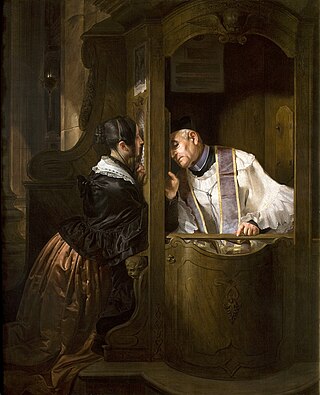
Absolution is a theological term for the forgiveness imparted by ordained Christian priests and experienced by Christian penitents. It is a universal feature of the historic churches of Christendom, although the theology and the practice of absolution vary between Christian denominations.

The Penitential Act is a Christian form of general confession of sinfulness that normally takes place at the beginning of the celebration of Mass in the Roman Rite of the Catholicism, as well as in Lutheranism. In Anglicanism, it is said as part of the Eucharist, but it is not considered an official sacrament.

A grace is a short prayer or thankful phrase said before or after eating. The term most commonly refers to Christian traditions. Some traditions hold that grace and thanksgiving imparts a blessing which sanctifies the meal. In English, reciting such a prayer is sometimes referred to as "saying grace". The term comes from the Ecclesiastical Latin phrase gratiarum actio, "act of thanks." Theologically, the act of saying grace is derived from the Bible, in which Jesus and Saint Paul pray before meals. The practice reflects the belief that humans should thank God who is believed to be the origin of everything.
The Improperia are a series of antiphons and responses, expressing the remonstrance of Jesus Christ with his people. Also known as the Reproaches or the Solemn Reproaches, they are sung In the Catholic liturgy as part of the observance of the Passion, usually on the afternoon of Good Friday. In the Byzantine Rite, they are found in various hymns of Good Friday and Holy Saturday. The Improperia appear in the Pontificale of Prudentius (846–61) and gradually came into use throughout Europe in the eleventh and twelfth centuries, finally being incorporated into the Roman Ordo in the fourteenth century.
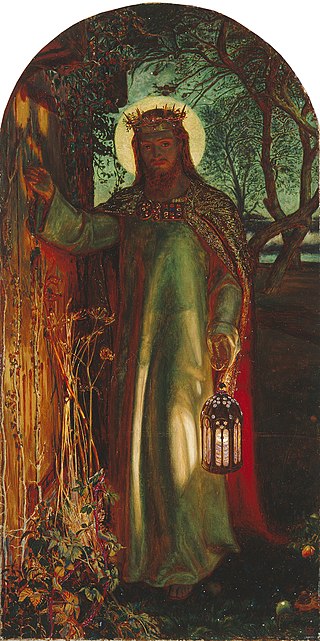
The Sinner's prayer is an evangelical term referring to any prayer of repentance, prayed by individuals who feel sin in their lives and have the desire to form or renew a personal relationship. This prayer is not mandatory but, for some, functions as a way to communicate with and understand their relationship with God through Jesus Christ. It is a popular prayer in evangelical circles. While some Christians see reciting the Sinner's prayer as the moment defining one's salvation, others see it as a beginning step of one's lifelong faith journey.

The oil of catechumens, also known as the oil of exorcism, is the oil used in some traditional Christian churches during baptism; it is believed to strengthen the one being baptized to turn away from evil, temptation and sin.
The Divine Service is a title given to the Eucharistic liturgy as used in the various Lutheran churches. It has its roots in the Pre-Tridentine Mass as revised by Martin Luther in his Formula missae of 1523 and his Deutsche Messe of 1526. It was further developed through the Kirchenordnungen of the sixteenth and seventeenth centuries that followed in Luther's tradition.
Baptismal regeneration is the name given to doctrines held by the Catholic, Eastern Orthodox, Oriental Orthodox, Lutheran, Anglican churches, and other Protestant denominations which maintain that salvation is intimately linked to the act of baptism, without necessarily holding that salvation is impossible apart from it. Etymologically, the term means "being born again" "through baptism" (baptismal). Etymology concerns the origins and root meanings of words, but these "continually change their meaning, ... sometimes moving out of any recognisable contact with their origin ... It is nowadays generally agreed that current usage determines meaning." While for Reformed theologian Louis Berkhof, "regeneration" and "new birth" are synonymous, Herbert Lockyer treats the two terms as different in meaning in one publication, but in another states that baptism signifies regeneration.

Thanksgiving after Communion is a spiritual practice among Christians who believe in the Real Presence of Jesus Christ in the Communion bread, maintaining themselves in prayer for some time to thank God and especially listening in their hearts for guidance from their Divine guest. This practice was and is highly recommended by saints, theologians, and Doctors of the Church.
Good Friday Prayer can refer to any of the prayers prayed by Christians on Good Friday, the Friday before Easter, or to all such prayers collectively.
In Lutheranism, the Eucharist refers to the liturgical commemoration of the Last Supper. Lutherans believe in the real presence of Christ in the Eucharist, affirming the doctrine of sacramental union, "in which the body and blood of Christ are truly and substantially present, offered, and received with the bread and wine."

Blessed salt has been used in various forms throughout the history of Christianity. Among early Christians, the savoring of blessed salt often took place along with baptism. In the fourth century, Augustine of Hippo named these practices "visible forms of invisible grace". However, its modern use as a sacramental remains mostly limited to its use with holy water within the Anglican Communion and Roman Catholic Church.
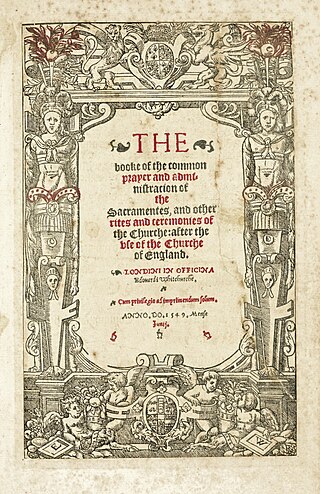
The 1549 Book of Common Prayer (BCP) is the original version of the Book of Common Prayer, variations of which are still in use as the official liturgical book of the Church of England and other Anglican churches. Written during the English Reformation, the prayer book was largely the work of Thomas Cranmer, who borrowed from a large number of other sources. Evidence of Cranmer's Protestant theology can be seen throughout the book; however, the services maintain the traditional forms and sacramental language inherited from medieval Catholic liturgies. Criticised by Protestants for being too traditional, it was replaced by the significantly revised 1552 Book of Common Prayer.
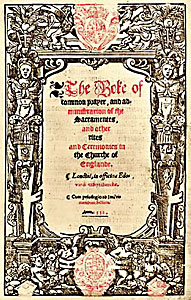
The 1552 Book of Common Prayer, also called the Second Prayer Book of Edward VI, was the second version of the Book of Common Prayer (BCP) and contained the official liturgy of the Church of England from November 1552 until July 1553. The first Book of Common Prayer was issued in 1549 as part of the English Reformation, but Protestants criticised it for being too similar to traditional Roman Catholic services. The 1552 prayer book was revised to be explicitly Reformed in its theology.